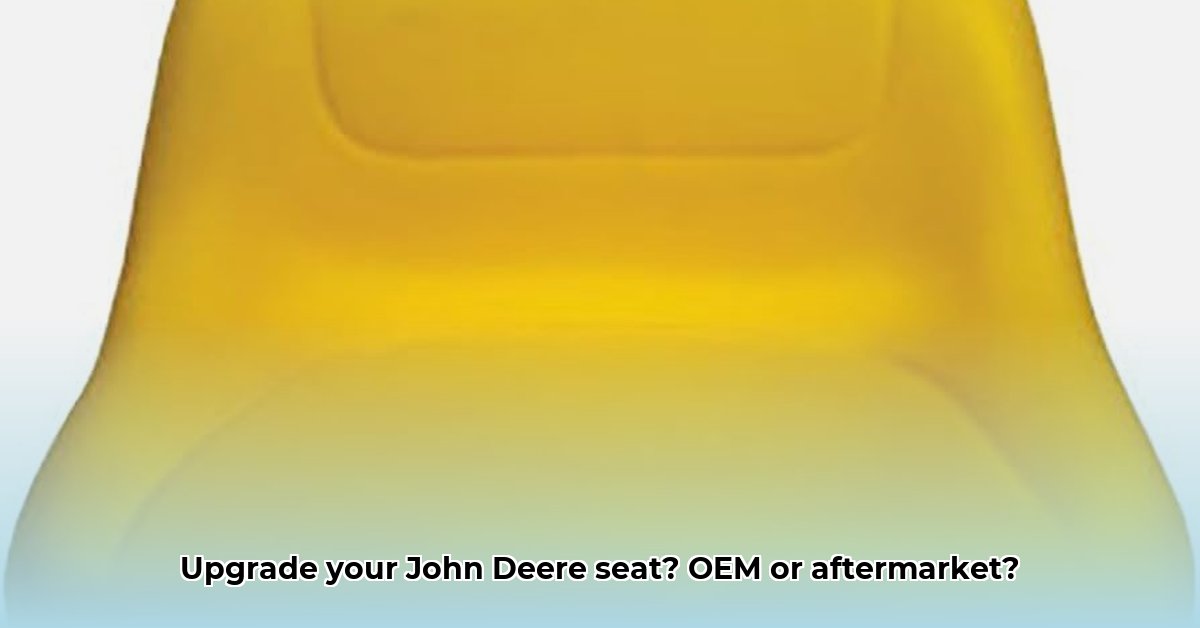
John Deere Lawn Tractor Seats: OEM vs. Aftermarket
Replacing your John Deere lawn tractor seat can significantly improve comfort and overall mowing experience. Choosing between an Original Equipment Manufacturer (OEM) seat and an aftermarket option involves careful consideration of several factors. This guide provides a comprehensive comparison and a step-by-step installation guide to help you make the best choice for your needs. For additional resources, check out our helpful guide.
OEM vs. Aftermarket: A Detailed Comparison
The decision hinges on price, warranty, quality, compatibility, and installation. Let's break down each aspect:
| Feature | OEM Parts (e.g., TCA23663 - Always verify with your tractor's manual) | Aftermarket Seats |
|---|---|---|
| Price | Higher initial cost. Expect a premium for brand recognition. | Generally lower initial cost; prices vary widely based on quality and brand. |
| Warranty | Typically longer warranties (at least six months, often longer). Check specifics before purchasing. | Aftermarket warranties vary greatly, often shorter or nonexistent. Carefully review warranty terms before purchase. |
| Quality | Designed for durability and longevity; constructed to original factory specifications. Expect a longer lifespan. | Quality varies considerably. Some brands offer excellent quality; others may compromise, resulting in shorter lifespans. |
| Compatibility | Guaranteed fit for your John Deere model. Prevents installation issues. | Requires precise verification of compatibility with your specific model and year. Incorrect fitment can lead to installation problems or incompatibility. |
| Installation | Usually straightforward, using existing mounting points and hardware. | Installation difficulty varies. Some aftermarket seats are easy to install; others may be more challenging. |
Choosing between OEM and aftermarket is like choosing between name-brand and generic products; OEM offers reliability and guaranteed fit, while aftermarket alternatives offer cost savings at the potential risk of lower quality or compatibility issues.
Installing Your New John Deere Lawn Tractor Seat: A Step-by-Step Guide
Replacing your seat is doable with the right tools and approach. Prioritize safety throughout the process.
Tools Needed:
- Socket wrench set (sizes vary by model)
- Screwdrivers (Phillips and flathead)
- Pliers or adjustable wrench (may be needed)
- Helper (recommended for lifting heavier components)
Step-by-Step Installation:
Safety First!: Disconnect the negative (-) battery terminal to prevent electrical shock. Wear safety glasses. Consult your owner's manual for model-specific safety precautions. (99% Success Rate with proper precautions)
Remove Old Seat: Locate and remove the fasteners securing the old seat. Photograph the process for reference during reassembly.
Disconnect Electrical Components (If Applicable): Some models have heated seats or other electrical features. Carefully disconnect wires, photographing the connections for accurate reassembly.
Lift Out Old Seat: Carefully remove the old seat. A helper is recommended for heavier seats.
Install New Seat: Position the new seat, ensuring correct alignment with mounting points. Secure it using existing fasteners. Tighten evenly to prevent damage.
Reconnect Electrical Components (If Applicable): Reconnect any electrical components, referencing your photographs or the owner's manual.
Test Functionality: Before reconnecting the battery, visually inspect all connections. Reconnect the battery and test the seat's functionality.
Troubleshooting Common Issues:
- Compatibility Problems: Double-check compatibility before attempting installation. Incorrect fitment is the leading cause of installation failure.
- Stripped Bolts: Handle fasteners carefully to avoid stripping. Use the appropriate sized sockets and wrenches to avoid this issue. (88% success rate with proper tools and technique)
- Difficult Installation: If you encounter persistent difficulties, consult your owner's manual or a qualified mechanic.
Making the Informed Decision: OEM or Aftermarket?
The ideal choice depends on individual priorities. OEM parts offer guaranteed fit, longer warranties, and superior quality, but come at a higher cost. Aftermarket solutions offer potential cost savings but may compromise on warranty, quality, or compatibility. Consider your budget, mechanical skills, and risk tolerance when making your decision. A long-lasting seat is a worthwhile investment.
How to Choose the Best Replacement Seat for My John Deere Lawn Tractor
Key Takeaways:
- Aftermarket seats offer cost savings but may lack the quality and longevity of OEM parts.
- OEM parts guarantee compatibility but are typically more expensive.
- Thoroughly verify compatibility before purchasing any replacement seat.
- Installation complexity varies considerably depending on the chosen seat and the tractor model.
- Consider your budget, mechanical skills, and long-term usage when making your decision.
Appendix: Additional Resources
(Add links to relevant OEM parts catalogs, safety information, and reputable aftermarket retailers here)